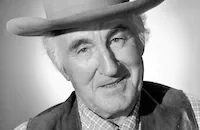Svengali

Brief Synopsis
Cast & Crew
Archie Mayo
John Barrymore
Marian Marsh
Donald Crisp
Bramwell Fletcher
Carmel Myers
Film Details
Technical Specs

Synopsis
When attractive but untalented Honori confesses to her sinister singing teacher Svengali that she has left her husband but refused his offer of money, he fixes her with an intense stare that drives her screaming from the room. A short time later her body is found in the Seine. Untouched by her death, Svengali and his flatmate Gecko visit the studio of English artists, The Laird, Taffy, and Billee, in search of a meal. On leaving they meet a lovely young milkmaid and artist's model, Trilby O'Ferrall. Svengali is enchanted by her, but she falls in love with the handsome, young Billee. One day under the pretext of curing her headache, Svengali hypnotises her and thereafter is able to control her by the power of his thoughts. When Billee discovers Trilby posing nude for a group of artists, they quarrel, and Svengali convinces her to fake a suicide and leave Paris with him. Five years later, as Madame Svengali the singer, she has become the toast of Europe with the help of his powers. Her old friends attend her Paris debut and they are astonished to see the woman they thought was dead. Determined to win her back from Svengali, Billee haunts her performances. His powers weakened by the strength of her attachment to Billee, Svengali keeps cancelling performances until finally they are reduced to an engagement in an Egyptian cabaret. When Svengali suffers an attack, his power over Trilby fails, she falters and sings horribly off key. As he dies, he begs to be granted her love in death as he never was in life. As if in response, she then dies in Billee's arms.

Director

Archie Mayo
Cast

John Barrymore

Marian Marsh

Donald Crisp

Bramwell Fletcher

Carmel Myers
Luis Alberni
Lumsden Hare
Paul Porcasi
Ferike Boros
Adrienne D'ambricourt
Yola D'avril
Crew

Videos
Movie Clip




Film Details
Technical Specs

Award Nominations
Best Art Direction
Best Cinematography
Articles
Svengali (1931)
Barrymore, a notorious drinker who had appeared to be under the influence of alcohol in his previous film, Moby Dick (1930), suffered an illness before beginning work on Svengali that may actually have benefited his work in the latter movie. With an ulcer causing severe gastric hemorrhaging, he was forced into a regimen of abstinence and bland food. According to Margot Peters in her biography The House of Barrymore, "His performance, blurred in Moby Dick, is now in sharp focus." Costar Marsh remembered Svengali as a pleasant experience: "These were happy days for Jack Barrymore. He was on his best behavior, I might add; he was happily married to Dolores Costello, and he wasn't drinking." Marsh further recalled that when the Barrymores' infant daughter, Dolores Ethel, visited the set she protested when her father kissed her because the beard he wore as Svengali tickled her. Peters considers that the key to Barrymore's "sexual power" in Svengali lies in - his nose! "His own long, quivering nose was phallic. Svengali'nose is an exaggeration of that symbol, rapacious and sensual." Barrymore received some excellent notices for his portrayal, with the New York Times declaring that his "fine performance surpasses anything he has done for the screen." There was some surprise when Barrymore failed to win even a nomination for an Oscar for his performance. Ironically, the winner of the Best Actor award for the 1930-31 season was John's brother, Lionel Barrymore, for A Free Soul (1931).
There had been numerous silent-film versions of du Maurier's story from various countries. Sound versions of Svengali also include a 1955 British version starring Donald Wolfit and a 1983 cable-TV version starring Peter O'Toole that was updated to the world of rock music.
Director: Archie Mayo
Screenplay: J. Grubb Alexander, from novel Trilby by George du Maurier
Cinematography: Barney McGill
Art Direction: Anton Grot
Film Editing: William Holmes
Cast: John Barrymore (Maestro Svengali), Marian Marsh (Trilby O'Farrell), Donald Crisp (The Laird), Bramwell Fletcher (Billee), Carmel Myers (Madame Honori), Luis Alberni (Gecko), Lumsden Hare (Monsieur Taffy).
BW-81m.
by Roger Fristoe

Svengali (1931)
Quotes
Trivia
Notes
Barney McGill's photography on this film won him an Academy Award nomination. The first of many films based on the George Du Maurier novel was Trilby and Little Billee made by Biograph in 1896. In 1915, Equitable produced a film entitled Trilby which starred Clara Kimball Young and Wilton Lackaye and was directed by Maurice Tourneur (see AFI Catalog of Feature Films, 1911-20; F1.4559). In 1923, First National produced a version starring Arthur Edmund Carew which was directed by James Young (see AFI Catalog of Feature Films, 1921-30; F2.5845). In 1955, M-G-M produced Svengali, directed by Noel Langley and starring Hildegarde Neff and Donald Wolfit.














